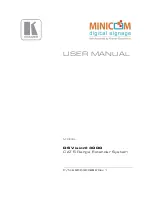
Antenna Kitting Information
www.SureCall.com | 1-888-365-6283 | [email protected]
9
Antenna Kitting Information
Component
Prod No. Description
Gain
LTE-A
LTE-V
800
MHz
1900
MHz
1700 MHz /
2100 MHz
Vehicle
Outdoor Antenna and Cable*
SC-202W and SC174-12.5 ft (12.5 ft)
-3.16 dB -5.15 dB -5.65 dB -2.85 dB -3.34 dB / NG
Outdoor Antenna and Cable*
SC200W and SC174-10 ft (10 ft)
-2.3 dB
-2.3 dB
-2.3 dB
-5.8 dB
-3.98 / -5.96 dB
Indoor Antenna and Cable*
SC110W and SC174-10 ft (10 ft)
-2.7 dB
-2.7 dB
-3.2 dB
-5.8 dB
-3.98 / -5.96 dB
Desktop / RV
Outdoor Antenna and Cable*
SC288W and SC240-40FN (40 ft)
-0.52 dB
-0.52 dB
-0.98 dB
-2.52 dB
-2.12 / -2.92 dB
Indoor Antenna*
SC120W whip
1.2 dB
1.2 dB
1.2 dB
3 dB
3 / 3 dB
Indoor Antenna and Cable*
SC302W and SC240-20FN (20 ft)
0.44 dB
0.44 dB
0.71 dB
1.44 dB
0.64 / 1.24 dB
*All equivalent antennas and cables are suitable for use with the BoostRV
Warning:
Unauthorized antennas, cables, and/or coupling devices are prohibited by FCC new rules. Changes
or modifications not expressly approved by SureCall could void the user’s authority to operate the
equipment.
FCC 27.50(d)(4) Statement:
Fixed, mobile and portable (hand-held) stations operating in the 1720-1755 MHz band
are limited 1 Watt EIRP. Fixed sta tions operating in this band are limited to a maximum antenna height of 10 meters
above ground. Mobile and portable stations operating in this band must employ a means for limiting power to the
minimum necessary for successful communications.
FCC 15.105 Statement
This equipment has been tested and found to comply with the limits for a Class B digital
device, pursuant to part 15 of the FCC Rules. These limits are designed to provide reasonable protection against
harmful interference in a residential installation. This equipment generates, uses and can radiate radio frequency
energy and, if not installed and used in accordance with the instructions, may cause harmful interference to radio
communications. However, there is no guarantee that interference will not occur in a particular installation. If this
equipment does cause harmful interference to radio or television reception, which can be determined by turning
the equipment off and on, the user is encouraged to try to correct the interference by one or more of the following
measures:
•
Reorient or relocate the receiving antenna.
•
Increase the separation between the equipment and receiver.
•
Connect the equipment into an outlet on a circuit different from that to which the receiver is connected.
•
Consult the dealer or an experienced radio/TV technician for help.
15.19
This device complies with Part 15 of the FCC Rules. Operation is subject to the following two conditions: (1)
this device may not cause harmful interference, and (2) this device must accept any interference received, including
interference that may cause undesired operation.






























